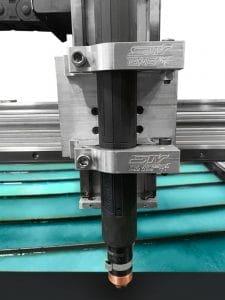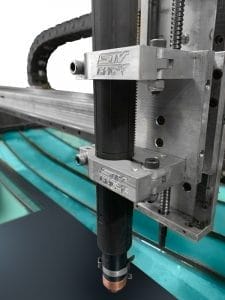What is a Water Table?
When working with a CNC plasma cutting table, it’s essential to have some way of controlling the dust and fumes from the cutting process. One solution is a water table (often referred to as a waterbed or a water pan), where the metal being cut is underneath a layer of water that prevents it from generating fumes. The other solutions are to use a dry table with no additional equipment to handle fumes and dust or a downdraft table where air flows down through the table and pulls dust and fumes away from the cutting area. While all three methods can be effective, each has its benefits and drawbacks. A water table does not require a dust collector (in most areas), reduces noise, eliminates dangerous arc flash, reduces heat distortion and keeps parts cool, just to name a few.
Advantages of Using a Water Table
- Price: The first point when people choosing their cutting table is the significant difference in the up-front price between a water table and other tables. Water tables are much less expensive up front. If the price is the only factor, then the decision is an easy one, choose the water cutting table.
- Materials: The varieties of materials you will be cutting are crucial in this decision-making process. If you are cutting steel/stainless steel, either type of table will serve well for you. Though, if you are cutting aluminum, water tables can offer a significant safety risk. Cutting over water also makes for cool to the touch parts, which are very easy to remove and use immediately.
- Operational Efficiencies: There are several factors to consider from an operational view when analyzing water tables and CNC plasma without water table. These factors include the size and type of parts you are cutting, plasma performance, and cut quality.
To select the best table for your purpose, it is necessary to consider all of these factors and the space you are working in. For example, a dry table setup in a home garage will result in a house full of smoke and fumes. Spending the time to judge your processes and long-term costs now will assure that you select the best, most cost-effective solution to your particular purpose.
Oxy-Fuel Cutting on a Water Table
The standard water table with water level control is designed to be used for both plasma and oxy-fuel cutting. When oxy-fuel cutting, the water cannot be above the plate surface, but it can be very close to the bottom of the plate. Also, there must be at lease an inch of water depth above the tray under the burning bars, to protect it from damage by the molten metal spray of the oxy-fuel cutting process.
Depending on material type, thickness, and quality requirements, some users prefer to cut with the water closer to the plate, so that the splashing water helps cool the part while cutting, reducing overall heat distortion. Other users want to avoid quenching of the slag that occurs, and therefore prefer to have the water level as far below the plate as possible. So whether you are plasma or oxy-fuel cutting, a water table is a simple and affordable alternative to a down draft table.



